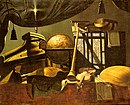|
Evaristo Baschenis Evaristo Baschenis (7 December 1617 – 16 March 1677) was an Italian Baroque painter of the 17th century, active mainly around his native city of Bergamo. BiographyHe was born to a family of artists. He is best known for still lifes, most commonly of musical instruments. This could explain his friendship with a family with notable violin makers from Cremona. Still-life depiction were uncommon as a thematic among Italian painters prior to the 17th century. Baschenis, along with the more eccentric 16th-century painter Milanese Arcimboldo, represents provincial outputs with idiosyncratic tendencies that appear to appeal to the discernment of forms and shapes rather than grand manner themes of religious or mythologic events. For Arcimboldo, the artifice is everything; for Baschenis, the items, man-made musical instruments, have a purpose and a beauty even in their silent geometry. One source for his photographic style of still life could be Caravaggio's early painting of peaches, or alternatively, Dutch paintings. The most faithful imitator of his style is a younger contemporary Bergamese, Bartolomeo Bettera. Baschenis is a contemporary of the Bergamese portrait artist, Carlo Ceresa, and appears to have been influential for the Modenese artist Cristoforo Munari. Critical receptionThe rapid success achieved by the painter early on in Bergamo and other Italian centers (Milan, Venice, Turin, Florence, Rome) is attested to not only by the numerous works present in the private collections of the time and by the large number of copies and imitations derived by anonymous painters from his models (a trend which came to be known as the maniera bergamasca, and which persisted down to the beginning of the nineteenth century), but also by the written sources, which praise Baschenis's extraordinary capacity for realistic representation and his inventiveness. In the very year of his death (1677), a brief but significant testimonial by Father Donato Calvi, prior of the Monastery of Sant'Agostino in Bergamo and a fine connoisseur a of the arts, offered praise of the painter which is also a useful guide to the way in which Baschenis's work was understood by the people of the time:
In Mgr. Bottari's «Pictorial Letters» (1822, IV, p. 22), there is a letter of Antonio Lupis addressed to Baschenis, supplied by Count Giacomo Carrara who greatly helped the Roman Scholar in compiling that renowned collection, which is worth quoting here. The tone is swollen, the hyperbole somewhat ponderous with baroque turns of phrase. But the writer's enthusiasm is soundly based upon critical reasons, or at least upon those of taste:
Gallery
Sources
External linksWikimedia Commons has media related to Evaristo Baschenis.
|





